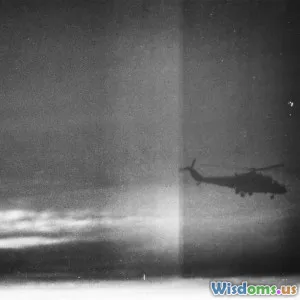
Are UFOs Secret Military Craft Fact Checking the Most Persistent Claims
9 min read Explore the truth behind UFO sightings by fact-checking claims that they are secret military craft in this detailed analysis. (0 Reviews)
Are UFOs Secret Military Craft? Fact-Checking the Most Persistent Claims
Unidentified Flying Objects, or UFOs, have captivated human imagination and curiosity for decades. Stories of strange lights, inexplicable aerial maneuvers, and encounters have spawned numerous theories—from alien visitors to advanced secret government experiments. But one of the most persistent explanations is grounded right here on Earth: that these UFOs are actually secret military craft. This article delves into that claim, sifting facts from speculation, exploring the evidence, and clarifying what is known about these mysterious objects.
Introduction: The UFO Phenomenon in Context
UFO sightings surged particularly after the 1940s, thanks notably to events like the 1947 Roswell incident and Kenneth Arnold's report of "flying saucers" near Mount Rainier. The U.S. military, intelligence agencies, and government have periodically investigated these phenomena—sometimes confirming misidentifications, sometimes maintaining secrecy.
In recent years, additional credibility has come to UFO reports via the release of Pentagon videos showing unexplained aerial phenomena (UAP) exhibiting advanced maneuvers. However, as certain as mystery surrounds these videos, many experts suggest the objects may be classified military technology rather than extraterrestrial spacecraft.
Is this claim accurate? What evidence supports or refutes it? Let’s break down the narrative.
The Origin of the "Secret Military Craft" Theory
Post-WWII Military Innovation and UFO Reports
During the height of the Cold War, both the United States and Soviet Union were experimenting with groundbreaking aerospace technology, including stealth aircraft and hypersonic drones. The technology was often developed under strict secrecy for strategic advantage.
Notably, the U-2 spy plane was developed in the 1950s and flew at altitudes and speeds that civilian passengers could overlook as UFOs. Many UFO sightings from that era were later attributed to this plane and others like it.
Examples of Military Aircraft Misidentified as UFOs
- The U-2 Spy Plane: Its high altitude and unique silhouette caused many reports of strange, fast-moving lights.
- SR-71 Blackbird: This Mach 3 reconnaissance plane's appearance was often a source of confusion.
- F-117 Nighthawk Stealth Fighter: Tested in secret until the late 1980s, this triangular craft could fit many published descriptions of “unusual” flying objects.
This history establishes a precedent for UFO sightings being linked with advanced military technology, albeit the technology was not publicly known at the time.
Analyzing Pentagon UFO Videos and Official Statements
The 2017 and 2020 Pentagon Revelations
In 2017, The New York Times published articles revealing the Advanced Aerospace Threat Identification Program (AATIP), which studied UFO sightings, funded by the United States Department of Defense.
Videos released by the Pentagon show Navy pilots encountering aerial objects moving at incredible speeds and performing maneuvers that defy conventional physics. Yet, officials have remained deliberately vague, asserting no confirmation that these are alien spacecraft.
Expert Opinions: Military Technology or Alien Craft?
Experts like Dr. Bruce Maccabee, a physicist and U.S. Navy veteran, argue many sightings could be explained by cutting-edge human technology. Conversely, others like Harvard astrophysicist Avi Loeb urge open consideration of extraterrestrial possibilities.
So far, no definitive evidence conclusively confirms that UFOs represent alien craft or secret military equipment, but the possibility of highly classified programs is strong given the military’s history.
Declassified Documents and Known Secret Programs
Project Blue Book and Its Findings
From 1952 to 1969, Project Blue Book was the Air Force’s attempt to catalog and explain UFO reports. It concluded that most sightings were ordinary objects or natural phenomena, but a small percentage remained unexplained.
Modern Programs and Speculated Technologies
The continued existence of programs like AATIP suggests ongoing intelligence interest. Analysts have proposed that modern stealth drones, robotic aerial vehicles, or electromagnetically powered craft could contribute to recent sightings.
Example: The development of hypersonic vehicles, such as the AGM-183 ARRW (Air-Launched Rapid Response Weapon), shows the U.S. is pushing boundaries on speed and maneuverability, characteristics similar to some reported UFO behaviors.
Geopolitical Motivations for Concealing Military Craft
If UFOs are secret military craft, why such secrecy?
Protecting National Security Interests
Disclosing advanced technologies could compromise security and delay tactical advantages. By allowing or fostering UFO speculation, militaries might mask experimental aircraft testing.
Psychological and Strategic Misdirection
Historical precedent exists for deception in warfare tech. During WWII, fake designs and rumors tricked enemies about weapon capabilities. Concealing experimental aircraft could work the same way.
Counterarguments and Alternative Explanations
Misidentification and Sensor Limitations
Many experts point out that human error, atmospheric effects, and limitations of radar and infrared sensors contribute to misinterpretations. For example, reflective balloons, weather phenomena such as lenticular clouds, or optical illusions can mimic unusual aerial activity.
Extraterrestrial Hypothesis Remains Unproven
There is yet no irrefutable proof of alien visitation. While intriguing, the exotic maneuvers can sometimes be explained by sophisticated human tech or sensor glitches.
Conclusion: Where Does the Evidence Lead Us?
The most persistent claims that UFOs are secret military craft are grounded in substantial historical precedent and recent Pentagon acknowledgments of pursuing such phenomena. Numerous sightings once baffling and characterized by impossible maneuvers often align surprisingly well with plausible earthly technology under cloak and development.
While no publicly disclosed evidence confirms that all UFOs are secret military vehicles, decades of declassified projects, pilot testimonies, and futuristic aerospace developments strongly suggest that a significant portion could be.
Therefore, embracing scientific inquiry and encouraging transparent investigation into UFOs is vital—not only to demystify these sightings but to understand the extent of human technology and its implications.
Next time you glance up at an unexplained light in the sky, consider the blend of military ingenuity and human curiosity that fuels the “UFO” story. The truth may be closer and more fascinating than we imagine.
References & Further Reading
- U.S. Government Accountability Office. (2021). “Unidentified Aerial Phenomena: Preliminary Assessment.”
- The New York Times (2017). “Glowing Auras and ‘Black Money’: The Pentagon’s Mysterious U.F.O. Program.”
- Project Blue Book Archives. USAF.
- Micah Hanks, "Deep State Targeted: The Battlefield for UFO Disclosure and Secret Space Programs," 2019.
- Congressional Hearing on UAP, July 2022.
Author’s note: The discourse around UFOs and secret military craft continues evolving. Scrutiny, scientific rigor, and open dialogue remain keys to understanding these enigmatic objects.
Rate the Post
User Reviews
Popular Posts



















